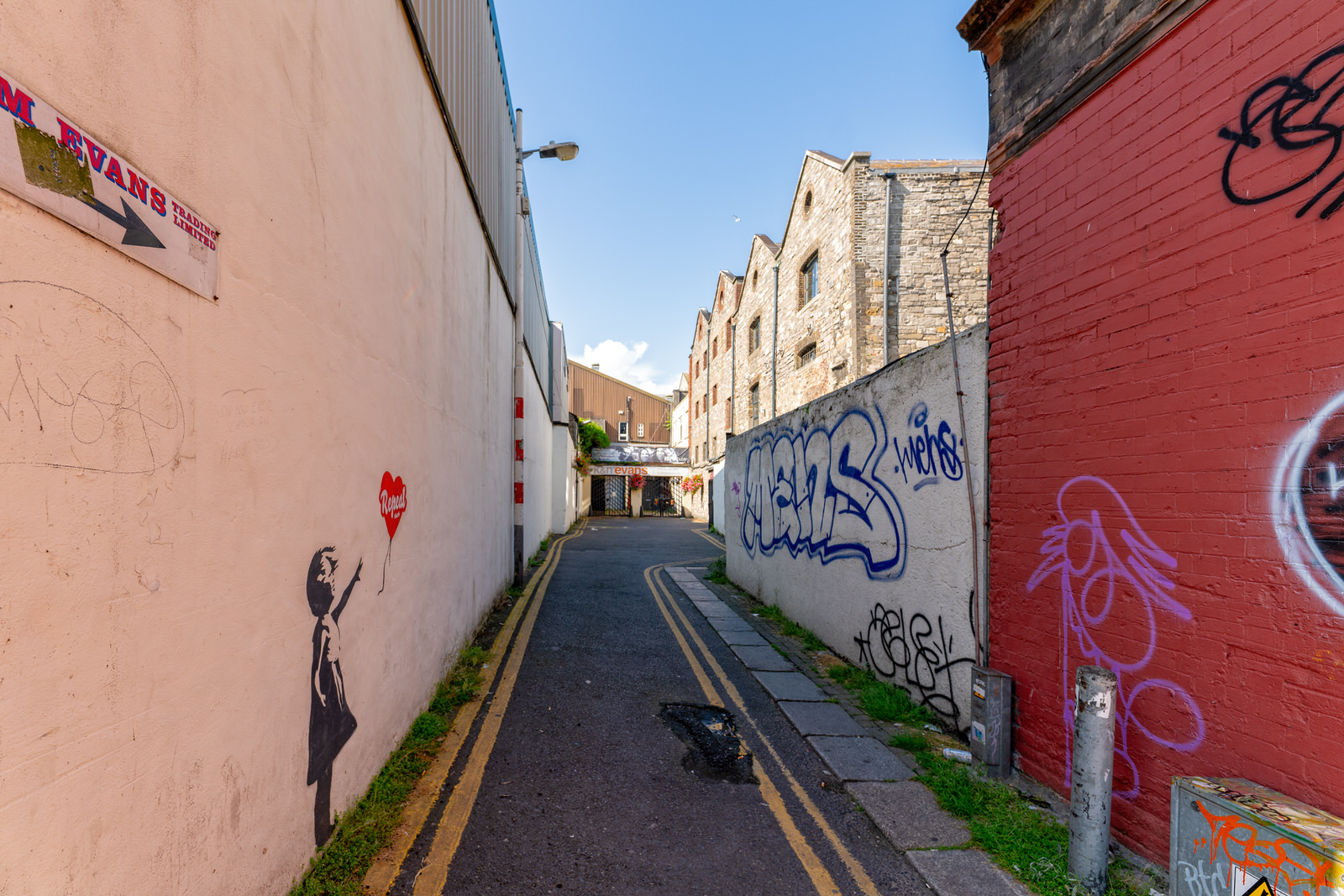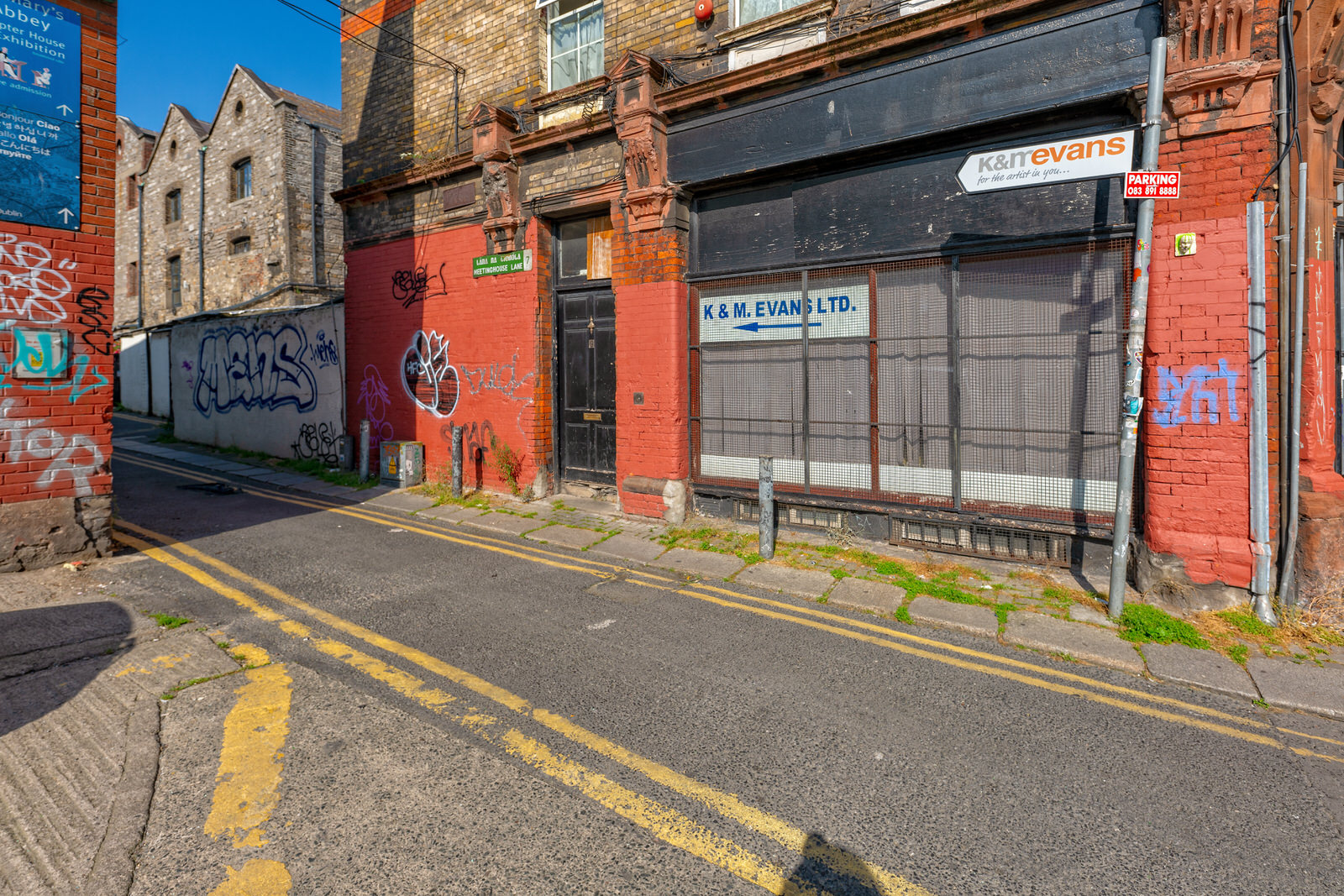MEETINGHOUSE LANE LOVE THE LANES OF DUBLIN
It should be noted that Meetinghouse Square is on the other side of the river in Temple Bar.
This lane is off a street named St. Mary's Abbey which can be a bit confusing as there is an interesting historic site at the end of the lane and it is St. Mary's Abbey.
St. Mary's Abbey was a former Cistercian abbey. Its territory stretched from the district known as Oxmanstown down along the River Liffey until it met the sea. It also owned large estates in other parts of Ireland. It was one of several liberties that existed in Dublin since the arrival of the Anglo-Normans in the 12th century, which gave it jurisdiction over its lands.
After the Dissolution of the Monasteries in 1539 the property was given over to John Travers and the church became an arsenal and part of a quarry. The spacious lands which had been owned by the monks came in time to be let to persons who desired to build residences or places of business thereon.
In 1619 Sir Gerald Moore of Mellifont, Drogheda, received from King James I of England a grant of the abbey, together with its tithes and lands. He later became Viscount Moore of Mellifont. The family of Moore made the Abbey their Dublin residence up to the close of the 17th century, and it was Henry Moore, 1st Earl of Drogheda, who built himself a mansion on what is now O'Connell Street, and developed Henry, Moore and Earl streets.
In 1676 the stones of the Abbey were used for the building of Essex Bridge (now Grattan Bridge, leading to Parliament St.)
Dr.Charles Lindsay (Charles Dalrymple Lindsay), Dean of Christ Church Cathedral, Dublin 1804–46 and afterwards Bishop of Kildare, acquired the old monastic lands of Glasnevin, which had once belonged to the abbey. These were purchased around 1832 to form what is now Glasnevin Cemetery.
The abbey was rediscovered, 7 feet (2 m) underground and underneath a bakery, in the 1880s, by an amateur archaeologist. His findings were publicised by John Thomas Gilbert. Parts of the old adjoining walls can still be seen. The building is now in the care of Heritage Ireland. The Chapter House was ordinarily open to visitors, by descending a stone staircase.
As of May 2015 the site is closed until further notice.
This lane is off a street named St. Mary's Abbey which can be a bit confusing as there is an interesting historic site at the end of the lane and it is St. Mary's Abbey.
St. Mary's Abbey was a former Cistercian abbey. Its territory stretched from the district known as Oxmanstown down along the River Liffey until it met the sea. It also owned large estates in other parts of Ireland. It was one of several liberties that existed in Dublin since the arrival of the Anglo-Normans in the 12th century, which gave it jurisdiction over its lands.
After the Dissolution of the Monasteries in 1539 the property was given over to John Travers and the church became an arsenal and part of a quarry. The spacious lands which had been owned by the monks came in time to be let to persons who desired to build residences or places of business thereon.
In 1619 Sir Gerald Moore of Mellifont, Drogheda, received from King James I of England a grant of the abbey, together with its tithes and lands. He later became Viscount Moore of Mellifont. The family of Moore made the Abbey their Dublin residence up to the close of the 17th century, and it was Henry Moore, 1st Earl of Drogheda, who built himself a mansion on what is now O'Connell Street, and developed Henry, Moore and Earl streets.
In 1676 the stones of the Abbey were used for the building of Essex Bridge (now Grattan Bridge, leading to Parliament St.)
Dr.Charles Lindsay (Charles Dalrymple Lindsay), Dean of Christ Church Cathedral, Dublin 1804–46 and afterwards Bishop of Kildare, acquired the old monastic lands of Glasnevin, which had once belonged to the abbey. These were purchased around 1832 to form what is now Glasnevin Cemetery.
The abbey was rediscovered, 7 feet (2 m) underground and underneath a bakery, in the 1880s, by an amateur archaeologist. His findings were publicised by John Thomas Gilbert. Parts of the old adjoining walls can still be seen. The building is now in the care of Heritage Ireland. The Chapter House was ordinarily open to visitors, by descending a stone staircase.
As of May 2015 the site is closed until further notice.


You will find links to buy products from Amazon, Google and other partners. If you click on these links, you’ll find that the URL includes a small extra piece of text which identifies that the click came from my websites. This text is an affiliate code, and it means that I get a small percentage of the money you spend if you choose to buy that product, or, in some cases, other products from the site soon after. These affiliate links help pay the costs of producing my websites and ensure that the content is free to you.
COPYRIGHT INFORMATION BELOW APPLIES ONLY TO PHOTOGRAPHS

This work by William Murphy aka Infomatique is licensed under a Creative Commons Attribution-NonCommercial-ShareAlike 4.0 International License.
Permissions beyond the scope of this license may be available at https://excellentstreetimages.com/in-the-year-twentytwenty/copyright/.
